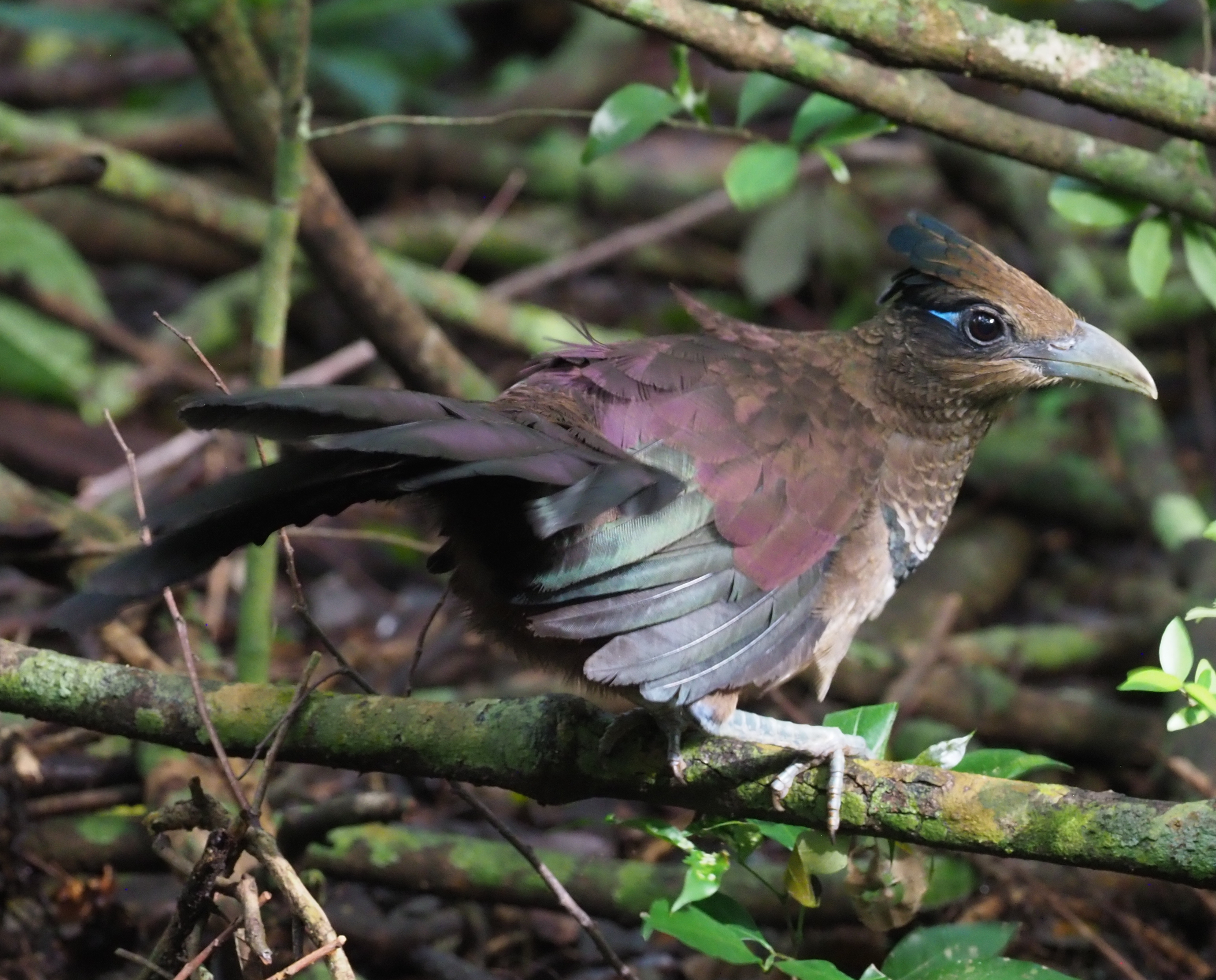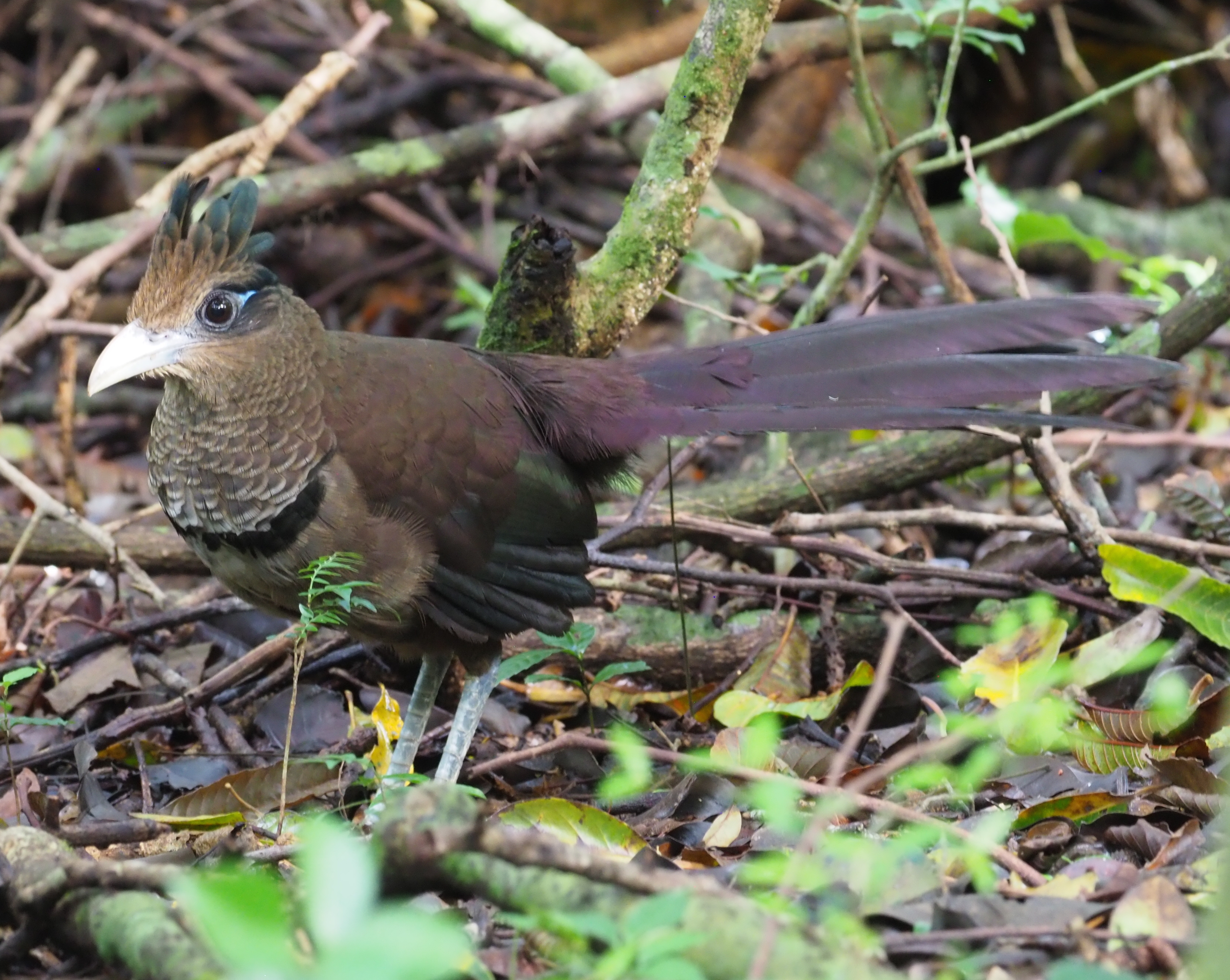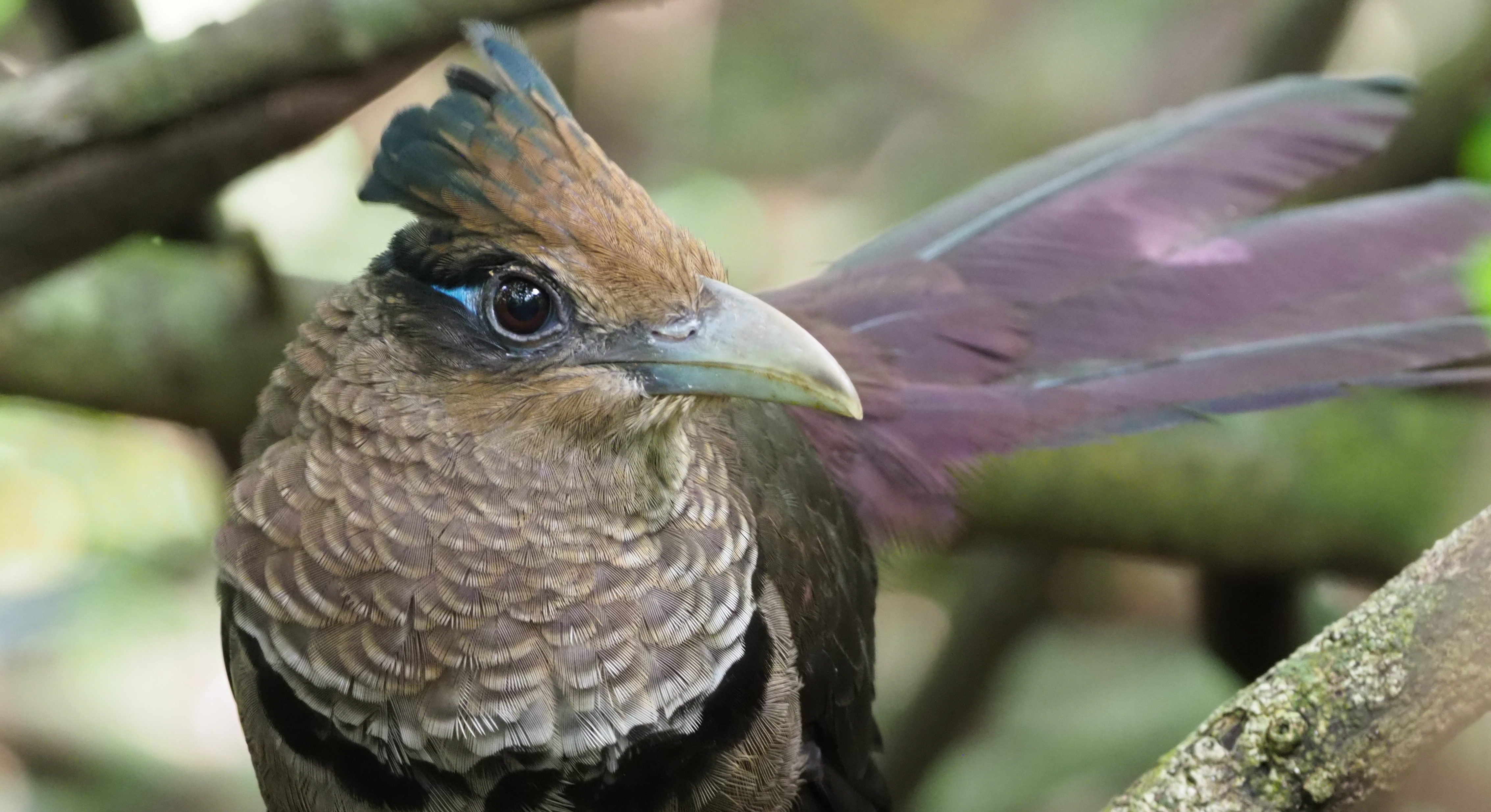
A fortuitous tale of a chance encounter between two Rockjumper leaders, and a mythical bird!
Stephan Lorenz
I decided to use some spare time at the end of 2020 and start of the new year to travel to Costa Rica to seek two dozen lifers and enjoy the amazing birds I had not seen in some years. The steps to enter Costa Rica are straightforward and COVID safety measures are taken throughout the country. I crisscrossed the country for several weeks, finding a great selection of new species like Nicaraguan Seed-Finch, the difficult Unspotted Saw-whet Owl, localized Ochraceous Pewee, and Rufous-necked Wood-Rail, to name a few. After two weeks, I had systematically whittled down the possibilities to a handful of species which included one of the most sought-after Neotropical birds — the Rufous-vented Ground-Cuckoo.
Peter Kaestner
I have long dreamed of birding Isla del Coco, the Cost Rican island in the eastern Pacific Ocean that served as the model for Isla Nublar in the Jurassic Park series. My attraction was not the possibility of finding clones of 75 million-year-old reptiles but rather the thee endemics, a cuckoo, flycatcher, and finch. To get to Isla del Coco, you must go on a ten-day live-aboard SCUBA dive boat, which is very expensive. Because of COVID, the dive boat was allowing birders to come along and the price was well under half of the normal fare. A Costa Rican birder, Serge Arias, was organizing a trip for January 2021, so I signed up with my wife, Kimberly. But this story is not about Isla del Coco. Since I was in Costa Rica, I decided to add on another 11 days to clean up the last nine birds I needed there.
I had been to Costa Rica twice before, and when I last left there were only a few birds missing, including the White-crested Coquette, Ochraceous Pewee, and Silvery-throated Jay. I also was missing the Rufous-vented Ground-Cuckoo, but it was so rare that I didn’t consider it. In the two decades since my last visit in 2001, however, taxonomic revisions resulted in several ‘new’ birds for me in Costa Rica: Vermiculated Screech Owl (IOC only), Chiriqui Foliage-gleaner, Isthmian Wren, Costa Rican Brushfinch, and Cabanis’s Ground-Sparrow. Since I love the clean things up, I had every intention of seeing all my target birds – including the mythical Rufous-vented Ground-Cuckoo. Could 20 years of birding progress in Costa Rica make it possible?
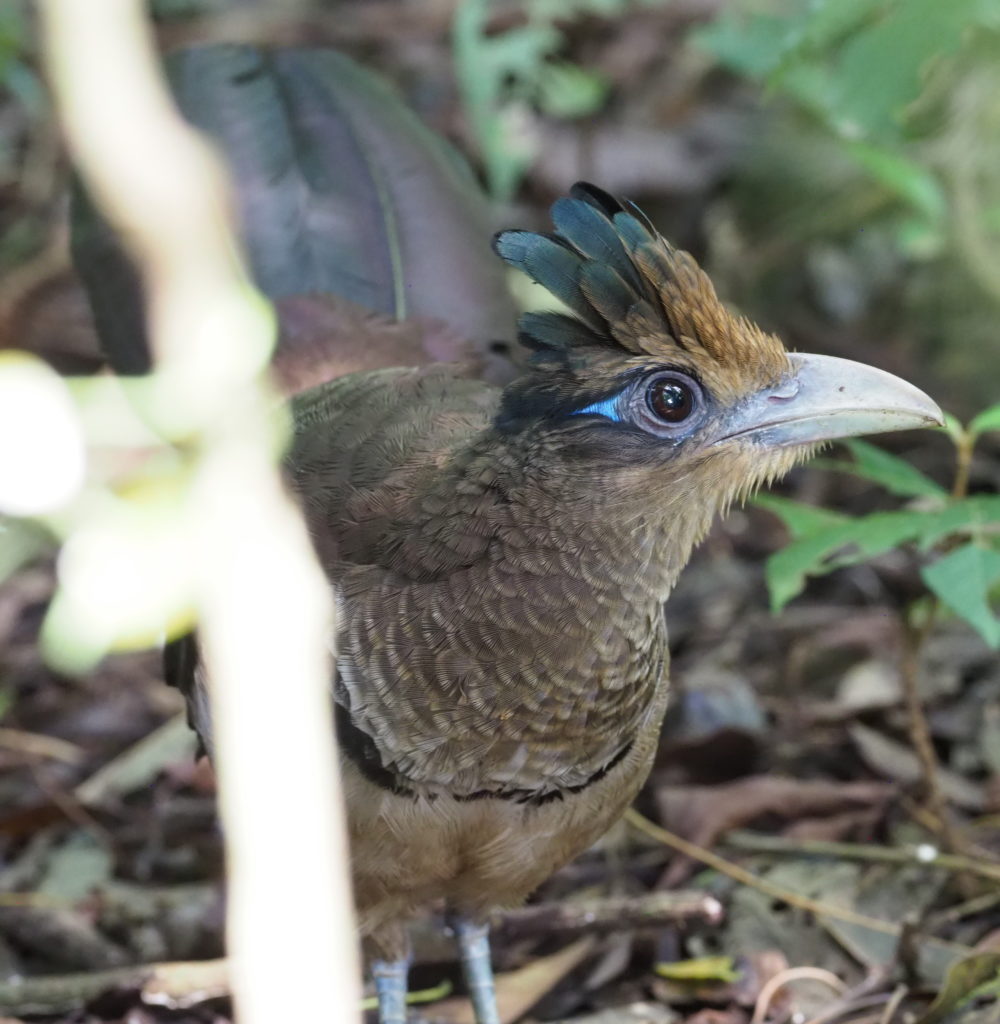
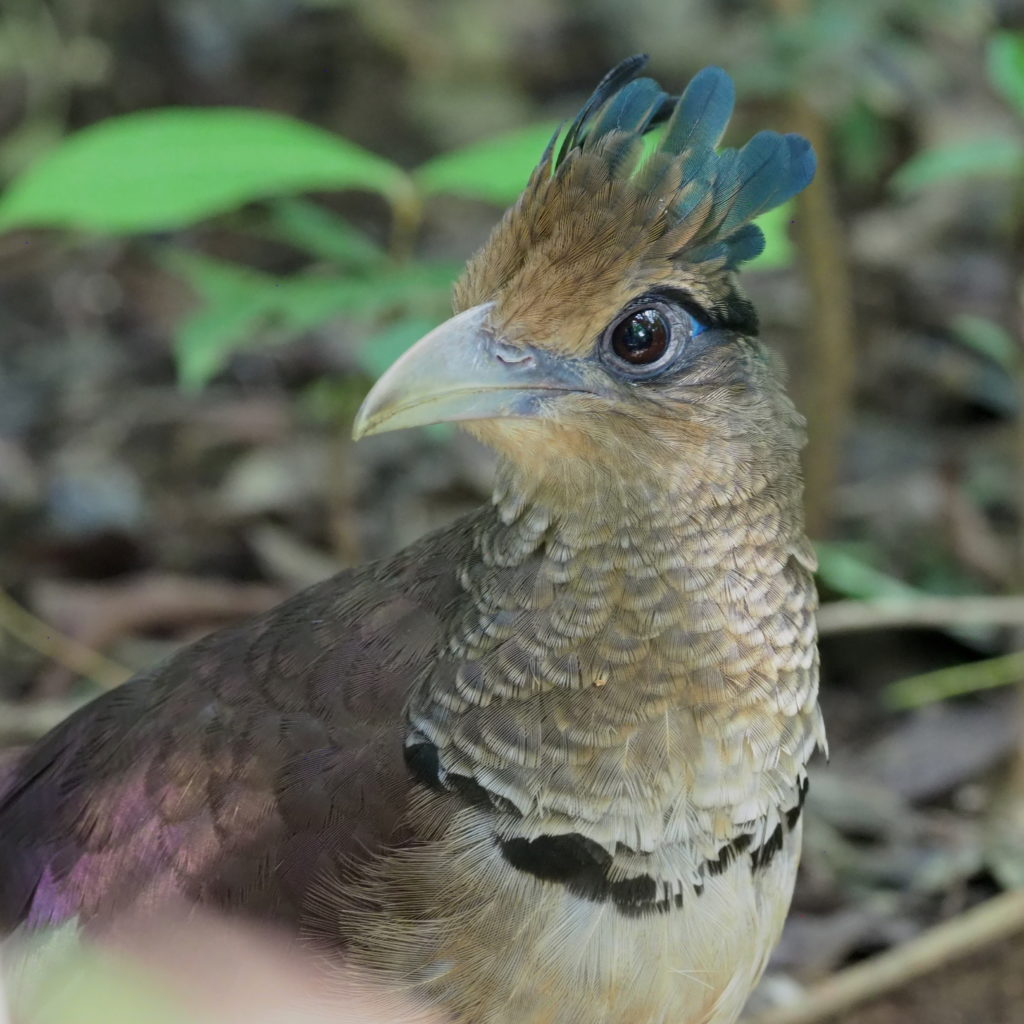
Stephan Lorenz
Even though this ground-cuckoo species is occasionally encountered in some locales during the right time of year (i.e. Panama), most birders would agree that it is indeed a tricky species as even veteran birders of the Neotropics have only seen it in the field guides. The Rufous-vented Ground-Cuckoo belongs to the genus Neomorphus which contains a further four species (Scaled, Banded, Rufous-winged, and Red-billed). All of them are exceedingly difficult to find. Of the five Neomorphus ground-cuckoos, the Rufous-vented has the widest distribution, ranging from Honduras south to southeast Brazil. Within this broad range, the species remains localized and is found in mature rainforest habitats of lowlands and foothills. The species appears to be dependent on large tracts of relatively undisturbed forest.
Rufous-vented Ground-Cuckoos feed mainly on insects, spiders, and millipedes, but will also consume small vertebrates and fruit. The species is most often encountered while following other animals that flush prey, mainly army ants, but also peccaries and monkeys. Ground-cuckoos most frequently associate with active army ant swarms. These swarms of army ants — often millions of ants — move in wide columns across the forest floor and throughout the understory, overwhelming arthropods with sheer numbers. Beetles, spiders, cockroaches, millipedes, crickets, and everything else small and medium leaves cover to escape the onslaught. This makes them easy prey for birds that methodically follow these ant swarms. I have seen a wide variety of bird species engaging in this essentially parasitic foraging style including curassows, tinamous, screamers, forest-falcons, hawks, antthrushes, tanagers, and warblers, but it is a suite of antbirds and woodcreepers that specialize in this behavior — with the ground-cuckoo being the apex ant-follower. Neomorphus ground-cuckoos are generally shy and run in quick dashes through the undergrowth, but are also known to perch motionless on a log or low vine for lengthy periods.
Checking the eBird database for all of Costa Rica revealed recent ground-cuckoo sightings in the Guanacaste Region in the northwest of the country, specifically in the large Rincon de la Vieja National Park. Having a few days left in Costa Rica, my wife, Claudia, and I decided to give it a go and drove north from Monteverde. We found an excellent campsite just outside the national park and settled in for at least three nights.
Peter Kaestner
After my Cocos adventure, I hired Kevin Easley of Costa Rica Gateway, one of the countries most knowledgeable birders, to take my wife, Kimberly, and I around this beautiful country. We got all the normal targets without drama, and were ending our stay faced with the biggest challenge – the ultra-rare and super-shy Rufous-vented Ground-Cuckoo. Kevin had a couple of sites for the enigmatic bird, but no recent sightings. His preferred site was on the eastern slope, which was being lashed by hurricane-force wind-driven rain on January 20.
I went on to eBird and saw that there was a record for the ground-cuckoo on January 7, just nine days ago, in the Rincon de la Vieja National Park, not far from Kevin’s site. Oddly, the eBird checklist was just a single bird species and was near, but not at, an eBird hotspot at the park. I assumed that the reason for the odd location of the checklist was that the bird was at that precise spot. While we did not know the observer, and the checklist was clearly imprecise as far as the birds, I banked that the location was, indeed, accurate. What we needed now was to find an ant swarm, since the ground-cuckoo is normally found hunting the small animals that are dislodged by the veracious ants.
As we got out of our car in the park’s main parking lot, we noticed someone familiar getting out of the adjacent car. Stephan Lorenz! I had long known of the young birding Rockstar, and was excited to see him and his lovely wife Claudia in person. After the obligatory socially-distanced selfie, he mentioned that he was looking for the Rufous-vented Ground-Cuckoo, and we wished each other luck.
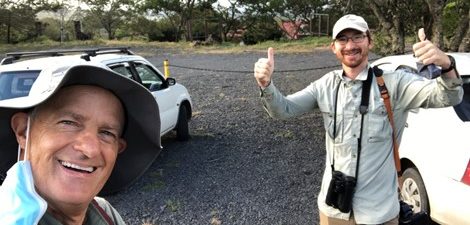
Peter Kaestner
As we walked up the main trail into the park, Kevin noticed a Gray-headed Tanager, a bird that characteristically accompanies ant swarms. And it was just about the same place where the suspect eBird checklist had indicated the presence of a ground-cuckoo on January 7. The first day, I spent most of the time standing in the area, and watching some ants in a modest swarm. There were many Gray-headed Tanagers, Ruddy Woodcreepers, Banded Wrens, and several warblers. The weather was terrible, with gale-force winds and occasional light rain. I was completely soaked and quite cold from standing still for hours at a time. Once I got back to the hotel at the end of the day, I texted Stephan and told him we had struck out.
Stephan Lorenz
Given the rarity and difficult nature of the Rufous-vented Ground-Cuckoo, I decided to return for another full day to explore the trails. Claudia stayed behind in the camp, which ended up being a good decision given the rough weather for most of the day. First thing in the morning, I again found the ant swarm from the previous evening and staked it out for thirty minutes. Despite the frenzied activity of Grey-headed Tanagers, Ruddy Woodcreepers, an Ovenbird, Rufous-capped Warblers, and no less than three Great Curassows, no ground-cuckoo appeared to be present so I moved on to one of the longer trails in the park. The hike turned into a long, wet slog as the gusty winds lashed the canopy and drizzle turned into occasional downpours, leaving me completely soaked.
Peter Kaestner
The next day we started late and I committed to spending every minute at the eBird site. Kevin went off to find a better ant swarm, and I began my vigil. After a while, I saw a nice swarm and entered into the forest along a deer-trail about 50 feet and sat down on a rock directly in the way of approaching swarm. There were many birds feasting on the insects flushed by the ants including Gray-headed Tanagers, Ruddy Woodcreepers, Banded Wren, Wood Thrush, and Rufous-capped Warblers. I kept on the lookout for a shy, stalking bird on the ground, expecting that the ground-cuckoo would approach like a cat, warily approaching the swarm. I settled in for a long wait.
Boy, was I wrong! After almost an hour of silent, still waiting, I noticed off at about the farthest point that I could see in the undergrowth, a long, purple tail flashing by a small opening in the undergrowth. It was a ground-cuckoo! It appeared to be chasing the half-dozen Ruddy Woodcreepers that were actively hunting over the ant swarm. As I watched, the bird would zoom back and forth as it interacted with the woodcreepers. Finally, it hopped up onto a perch about a half-meter above the ground. I got some terrible photos (it was raining, so inside the forest was gloomy) and waited, since the swarm was headed my way. What a great feeling to have been able to find one of the most difficult birds in Costa Rica! In order that others looking for the bird would know the details, I made an eBird checklist for the 15 minutes I spent with the wonderful bird, noting the exact time, location, and associated species. ( https://ebird.org/checklist/S79648435 )
Over 15 minutes, the birds all slowly came towards me, excitedly snapping up the animals fleeing the ant swarm. The Rufous-vented Ground-Cuckoo at one point rounded a tree about 12 meters away, but it stared at me, turned around, and loped off into the forest. Assuming that my magical 15 minutes with the bird was finished, I hurried off to find Kevin and give him the good news. Since it was midday, we headed to the hotel to see if I could connect with my wife, Kimberly. Once in my room, I sent Stephan a text message (I did not have a Costa Rican SIM card in my phone.) telling him where and when I got the magical bird.
Stephan Lorenz
After midday, I had finished the trails and was approaching the exit of the park when I received a message on my phone. It was from Peter and the first three words snapped me alert: “Got the Bird!!!”, followed by brief details of where and when. I had just passed that exact spot and quickly turned around. Upon reaching the area, I slowly maneuvered through some dense tangles into the second growth which was surprisingly open due to extensive work by leafcutter ants that had thinned out the foliage. I immediately spotted some Grey-headed Tanagers and Ruddy Woodcreepers plus a Great Curassow — luckily the ant swarm was still here and appeared to be active. I tried to gauge the activity of the birds to find the best vantage point, hoping to conceal myself a bit, but soon realized that I was hunkered down exactly in front of the ant activity, leading me to relocate at a good clip. I hid again in a better spot and waited. Half-dozen Grey-headed Tanagers flew in, perching in strategic positions and occasionally sallying down to snatch up hapless insects fleeing from the marauding ants. A few Ruddy Woodcreepers also reappeared, these would cling to the side of a small tree trunk and survey the situation calmly, often sitting still for an extended period before dashing forth to snatch up prey. Although I was in the tropics, I actually became quite chilled due to my soaked clothes as I sat still.
The ant swarm veered off to my left, leaving me in an ideal spot to scan through the undergrowth as I looked for more substantial movement. I thought I heard a soft clack that could have been bill clapping. I waited for more than thirty minutes, sweeping back and forth with my binoculars. Looking left again without binoculars into an open area, I noticed something that was not there a moment ago — a long, glossy shape — I was looking at the tail of a ground-cuckoo sticking straight up into the air. I slowly lifted my binoculars, realizing that one of my most wanted species would come into focus in a second. I had imagined catching brief glimpses of the ground-cuckoo or piecing together partial views as the bird moved furtively through a thicket. Instead, there was a Rufous-vented Ground-Cuckoo fully in the open, leaning forward as it pecked at the ground with its glossy tail raised. The bird stood up and I could see the scaly breast feathers and dark band in detail and as it turned its head, I saw the hefty, yellow bill, blue behind the eye, and there was that crest, nervously twitching up and down. The bird stayed for another few seconds before slinking off behind some vegetation.
I had seen it, at last, now hopefully a photo. I waited in the same position a few more minutes, occasionally hearing clear bill clapping, and soon the ground-cuckoo re-emerged. This time it stuck around in the open for minutes on end, feeding in the same spot, and even investigating a hollow log, fluttering up to snatch at something inside. The views were spectacular and I was getting progressively clearer photos. At one point the bird had settled down in an area and I carefully moved closer. Realizing that the cuckoo was aware of me but seemed unperturbed, I inched forward. Eventually, I stood six feet from it as it rested on a vine right above the ants, the views were beyond what I had ever expected. I also found it interesting that the bird was not shy at all, essentially all the other ant following species had left, but the cuckoo appeared resolved to stay with the swarm until sunset. I retreated carefully, walking away from a Rufous-vented Ground-Cuckoo as it eyed me curiously.
Peter Kaestner
After an afternoon of zip-lining with Kimberly, I was doing some light birding along the entrance road to Rincon de la Vieja. At one place, we were looking at some nice Grove-billed Anis, when a car stopped nearby. Out jumped Stephan and Claudia! They were ecstatic, as Stephan had just come from spending 90 minutes in the company of ‘my’ ground-cuckoo. He showed me amazing photos of the bird from point-blank range in beautiful light. Stunning!
I suddenly was overwhelmed by a strong emotion of relief and delight and Stephan had seen the bird. Indeed, I felt more emotional about HIS seeing the bird than I had been when I saw it! I suddenly realized why am a Rockjumper leader. There is nothing more satisfying than helping someone find a great bird.
Stephan Lorenz
I returned to the campsite outside the park where Claudia had been waiting out the bad weather and I knew that we had to change our plans and go back for the ground-cuckoo the following morning. Fortunately, we ran into Peter and Kevin again in the evening and I was able to thank Peter for finding the bird and sharing the sighting.
Realizing that the ants didn’t become active until midmorning, we took our time the following day, packing up the camping gear and enjoying pinto and eggs for breakfast. We arrived at the park by 9 am and walked the five minutes to the spot, carefully and quietly maneuvering through the undergrowth. Despite glimpsing a Great Curassow there was no obvious activity of ants, birds, or anything in the area. We listened and looked, the Ovenbird marched by several times but didn’t appear to follow ants. In fact, everything was quiet. Starting at the spot where I had left the ground-cuckoo the previous afternoon, I began to circle through the forest, listening for activity and looking for ants. After nearly an hour of searching, I stumbled upon several Grey-headed Tanagers and miscellaneous other species, and looking closer I saw a thick column of ants. I retraced my route, quickly returned with Claudia, and after settling down way too close to the fast-moving ants at first, we found a better spot and started our vigil. Within moments, I thought we had success when I spotted a broad tail in a thicket, but it was a Squirrel Cuckoo that had descended from the canopy to take advantage of the easier prey. We waited and scanned and within fifteen minutes I caught the first glimpse of the actual ground-cuckoo as it briefly slunk into an opening in the thick undergrowth. Shuffling to a better position, we soon were both looking at it. After waiting patiently, the ground-cuckoo eventually came out into the open and again allowed a close approach. In the end, we stood within a few feet of the Rufous-vented Ground-Cuckoo as it foraged in the open right alongside the broadest column of ants.
It was an absolute thrill to see the bird for a second day and even better to be able to share it. I will always be indebted to Peter for patiently staking out the ant swarm for a day and a half and then readily sharing the sighting. Being able to share incredible birds and the natural world with others is one of the joys of leading tours.
